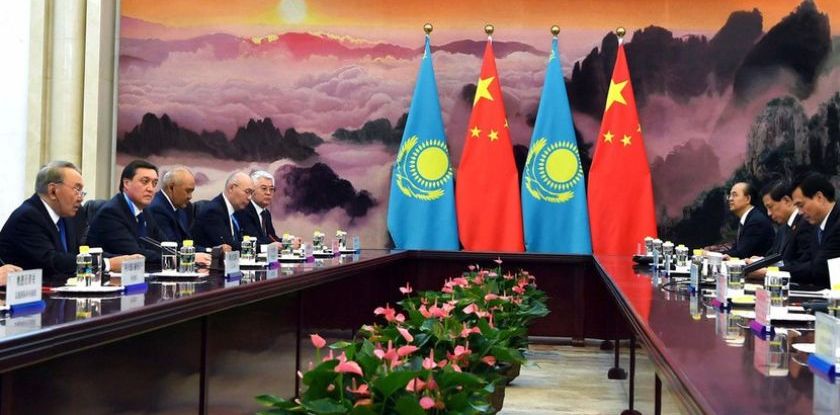China remains the main country that Akorda expects to invest in Kazakhstan, primarily, in the resource sector and the large-scale processing industries. This, however, is not to be reflected in the Kazakhstanis’ employment status. This conclusion follows the evaluation of the effectiveness of the Kazakhstan government’s investment program.
On February 27, 2018, they held a governmental meeting chaired by Bakytzhan Sagintayev. Among other things, the meeting addressed the issue of attracting foreign investments in the country. Judging by the key speeches (that of Investments and Development Minister Zhenis Kasymbek, First Deputy Minister of Foreign Affairs Mukhtar Tleuberdin, and Chairman of the Kazakh Invest state-owned company Saparbek Tuyakbayev), they are working on that, and quite actively, too.
We have no reason to suspect that the high-rank officials are lying but we believe it useful to attract the reader’s attention to the following important conclusions that one can draw from the public information presented in the press-release.
For instance, according to Zhenis Kasymbek, “based on the results of the 9 months of 2017, the volume of the gross investments inflow amounted to $15.8 bln which is 5.3% higher than the results of the same period of 2016”.
Apart from that, “The Ministry for Investments and Development together with JSC Kazakh Invest had formed the basic list of the 145 on-going investment projects amounting to $47.8 bln that includes the projects that are part of all the country cooperation programs including the Kazakhstan-China ones, the Kazakhstan-Turky ones, and the other investment projects”.
Note that “15 projects amounting to $27.7 bln are being implemented as part of the Kazakhstan-China cooperation; among them, 4 projects amounting to about $140 mln have been completed. In the current year, 5 projects with the Chinese participation with the investment volume of $623 mln are to be build”, and “the Kazakhstan-Turkey cooperation program (“The New Synergy”) consists of 26 projects”. In total, “in the current year, we expect to build two projects in the amount of $15.5 mln”. Also, “the basic list includes the other investment projects being implemented as part of the agreements reached by the Head of the state during the international visits”.
Generally speaking, “of the 145 projects, in the current year, we are planning to start building 15 projects in the amount of $1.6 bln. Later, the list will include the projects that will attract the resources of the international financial institutes including the public-private partnerships”.
In his turn, Chairman of Kazakh Invest Saparbek Tuyakbayev said that “following the needs of the economy, we had formed a list consisting of 145 projects with foreign participation in the amount of $47.8 bln that are to create about 35 thousand jobs. In 2018, our task is to attract investors to implement 17 large-scale projects in the amount of $16.4 bln”.
We believe the mentioned numbers demonstrate that –
- The Kazakhstan Government is primarily preoccupied with attracting large-scale investors. The fact that the average size of the expected investments in the projects included by the Ministry of Investments and Development into the basic list constitutes $330 mln testifies to that.
- At the same time, China is expected to be the main source of foreign investments. The Chinese businesses constitute 35.2% of all the investment projects included into the basic list and 57.9% of the total volume of the calculated investments.
- The Chinese investments in Kazakhstan will primarily affect the resource sector and the large-scale processing industry. This can be inferred from their average calculated size – $543 mln. Indirectly, this also testifies to the fact that China, more than the other countries, is interested in cracking the Kazakhstan market.
- The Chinese business is consistently increasing its investment activities in Kazakhstan. It follows from the fact that the average volume of investments in the 4 already completed projects amounted to $35 mln; for the 5 projects whose start is expected in 2018, this indicator equals to $125 mln; and, on the whole, the average volume of investments in the 51 Chinese investment projects included into the basic list amounts to $543 mln.
- Even a successful implementation of the government program on attracting foreign investments in Kazakhstan will be in no way reflected in the employment status of the population. Since the average value of one new worker will amount to $1.5 mln, it means that only the highly-qualified professionals that Kazakhstan does not have will be in demand. Besides, the number of the additionally created jobs is small and correlates to the 1.4% of the real number of the currently unemployed in the country.
As a result, in our opinion, the economic effectiveness of the government investment program will positively affect the performance of such macroeconomic indicators as the GDP and the country’s export as well as the state budget earnings but will have practically no influence on the employment-status as well as the real average wages (disposable income).




